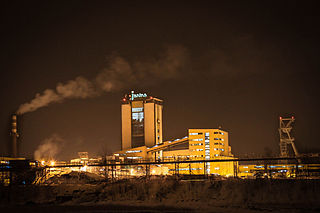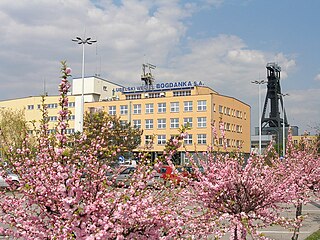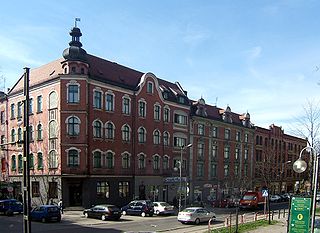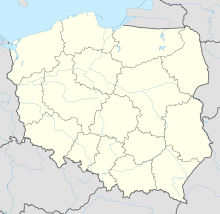A mining accident is an accident that occurs during the process of mining minerals. Thousands of miners die from mining accidents each year, especially from underground coal mining, although hard rock mining is not immune from accidents. Coal mining is considered much more hazardous than hard rock mining due to flat-lying rock strata, generally incompetent rock, the presence of methane gas, and coal dust. Most of the deaths these days occur in developing countries, and rural parts of developed countries.

The Farmington Mine disaster was an explosion that happened at approximately 5:30 a.m. on November 20, 1968, at the Consol No. 9 coal mine north of Farmington and Mannington, West Virginia, United States.

The Ulyanovskaya Mine disaster was caused by a methane explosion that occurred on March 19, 2007 in the Ulyanovskaya longwall coal mine in the Kemerovo Oblast. At least 108 people were reported to have been killed by the blast, which occurred at a depth of about 270 meters (885 feet) at 10:19 local time. The mine disaster was Russia's deadliest in more than a decade.

Mining in New Zealand began when the Māori quarried rock such as argillite in times prior to European colonisation. Mining by Europeans began in the latter half of the 19th century.

The 2009 Wujek-Śląsk mine blast occurred at the Wujek-Śląsk bituminous coal mine in Ruda Śląska, Poland on 18 September 2009. At least 20 miners were killed and at least 37 more were hospitalised. It is the country's deadliest mining accident since the deaths of 23 miners from methane at the Silesia's Halemba mine in November 2006. The death toll is expected to increase.

Coal mining is an important industry in Ukraine.
The Upper Big Branch Mine disaster occurred on April 5, 2010 roughly 1,000 feet (300 m) underground in Raleigh County, West Virginia at Massey Energy's Upper Big Branch coal mine located in Montcoal. Twenty-nine out of thirty-one miners at the site were killed. The coal dust explosion occurred at 3:27 pm. The accident was the worst in the United States since 1970, when 38 miners were killed at Finley Coal Company's No. 15 and 16 mines in Hyden, Kentucky. A state funded independent investigation would later find Massey Energy directly responsible for the blast.
Mining is an important industry in Pakistan. Pakistan has deposits of several minerals including coal, copper, gold, chromite, mineral salt, bauxite and several other minerals. There are also a variety of precious and semi-precious minerals that are also mined. These include peridot, aquamarine, topaz, ruby, emerald, rare-earth minerals bastnaesite and xenotime, sphene, tourmaline, and many varieties and types of quartz .

The Krupiński coal mine is a large mine in the south of Poland in Suszec, Silesian Voivodeship, 448 km south-west of the capital, Warsaw. Krupiński represents one of the largest coal reserve in Poland having estimated reserves of 34.8 million tonnes of coal. The annual coal production is around 3 million tonnes. The mine is based in Suszec, the deposits of which are located in the commune of Suszec, Żory and Orzesze in the Silesian Voivodeship. Employment at the end of 2011 amounted to 2819 employees. March 31, 2017 production in the mine was shut down and the plant was transferred to the Spółka Restrukturyzacji Kopalń in Bytom. This company is liquidating and managing the assets of liquidated mines.

The Janina coal mine is a large mine in the south of Poland in Libiąż, Lesser Poland Voivodeship, 350 km south-west of the capital, Warsaw. The mine has been erected by Compagnie Galicienne de Mines, a French mining company, in 1907. Between 1921 and 1939 the Janina mine was under management of its Polish chief executive, Zygmunt Szczotkowski. During World War II it was repurposed into one of the German Nazi concentration camps. After the war the Janina mine was nationalizated, as all enterprises with over 50 employees had been at that time.

The Bogdanka Coal Mine is a coal mine in the village of Bogdanka near Łęczna, in the vicinity of Lublin, 197 km south-east of Poland's capital, Warsaw, in the Lublin Coal Basin. The mineral-obtaining licence area where extraction takes place is located in the commune of Puchaczów.
The Bazhanov coal mine is a large coal mine located in southeastern Ukraine in Donetsk Oblast, in the industrial city of Makiivka. Bazhanov mine represents one of the largest coal reserve in Ukraine having estimated reserves of 58.7 million tonnes of coal. The annual coal production is around 1.02 million tonnes.
The Bilozerska coal mine is a large coal mine located in the south-east of Ukraine in Donetsk Oblast. The mine was put into operation in 1954 with annual production capacity of 1 million tons. Bilozerska represents one of the largest coal reserve in Ukraine having estimated reserves of 80.4 million tonnes of coal. In 2003 the mine produced 898.9 thousand tons of coal. The extent of underground workings is 82.6/80 km (1996/1999). As per 1999 data, number of employees was 2632 persons, including 1615 underground workers. The annual coal production is around 975,000 tonnes.
The Hirske coal mine is a large coal mine located in the south-east of Ukraine in Hirske, Luhansk Oblast. Hirske represents one of the largest coal reserves in Ukraine having estimated reserves of 46.5 million tonnes. The annual coal production is around 320,000 tonnes.
The Stakhanov coal mine is a large coal mine in the south-east of Ukraine in Donetsk Oblast. Stakhanov is one of the largest coal reserves in Ukraine, having estimated reserves of 139.7 million tonnes. The annual coal production is around 1.85 million tonnes.
The Sukhodilska–Skhidna coal mine is a large underground coal mine located in Southeast Ukraine in Luhansk Oblast. Sukhodilska–Skhidna coal mine represents one of the largest coal reserves in Ukraine having estimated reserves of 157.4 million tonnes. The annual coal production is around 712,000 tonnes.
Events during the year 2006 in Poland.














